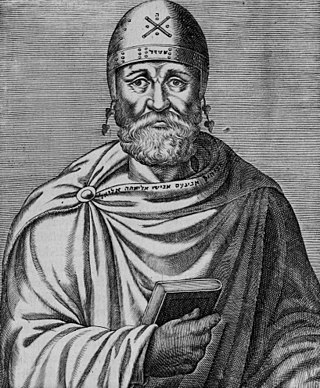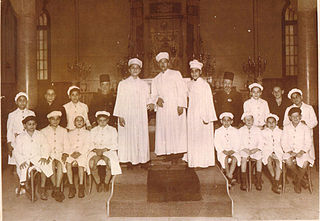Related Research Articles

Gaius Caesar Augustus Germanicus, better known by his nickname Caligula, was Roman emperor from AD 37 until his assassination in AD 41. He was the son of the Roman general Germanicus and Augustus' granddaughter Agrippina the Elder, members of the first ruling family of the Roman Empire. He was born two years before Tiberius was made emperor. Gaius accompanied his father, mother and siblings on campaign in Germania, at little more than four or five years old. He had been named after Gaius Julius Caesar, but his father's soldiers affectionately nicknamed him "Caligula".

The 30s decade ran from January 1, AD 30, to December 31, AD 39.
AD 39 (XXXIX) was a common year starting on Thursday of the Julian calendar. At the time, it was known as the Year of the Consulship of Augustus and Caesianus. The denomination AD 39 for this year has been used since the early medieval period, when the Anno Domini calendar era became the prevalent method in Europe for naming years.

Herod Agrippa, also known as Herod II or Agrippa I, was the last Jewish king of Judea. He was a grandson of Herod the Great and the father of Herod Agrippa II, the last known king from the Herodian dynasty. He was acquaintance or friend of Roman emperors and even played crucial roles in internal Roman politics.

A pogrom is a violent riot incited with the aim of massacring or expelling an ethnic or religious group, particularly Jews. The term entered the English language from Russian to describe 19th- and 20th-century attacks on Jews in the Russian Empire. Similar attacks against Jews which also occurred at other times and places became known retrospectively as pogroms. Sometimes the word is used to describe publicly sanctioned purgative attacks against non-Jewish groups. The characteristics of a pogrom vary widely, depending on the specific incident, at times leading to, or culminating in, massacres.

Philo of Alexandria, also called Philō Judæus, was a Hellenistic Jewish philosopher who lived in Alexandria, in the Roman province of Egypt.

The First Jewish–Roman War, sometimes called the Great Jewish Revolt, or The Jewish War, was the first of three major rebellions by the Jews against the Roman Empire fought in Roman-controlled Judea, resulting in the destruction of Jewish towns, the displacement of its people and the appropriation of land for Roman military use, as well as the destruction of the Jewish Temple and polity.
3 Maccabees, also called the Third Book of Maccabees, is a book written in Koine Greek, likely in the 1st century BC in either the late Ptolemaic period of Egypt or in early Roman Egypt. Despite the title, the book has nothing to do with the Maccabean Revolt against the Seleucid Empire described in 1 Maccabees and 2 Maccabees. Instead it tells the story of a persecution of the Jews under Pharaoh Ptolemy IV Philopator in Ptolemaic Egypt, some decades before the Maccabee uprising in Judea. The story purports to explain the origin of a Purim-like festival celebrated in Egypt. 3 Maccabees is somewhat similar to the Book of Esther, another book which describes how a king is advised to annihilate the Diaspora Jews in his territory, yet is thwarted by God.

The Jewish–Roman wars were a series of large-scale revolts by the Jews of Judaea and the Eastern Mediterranean against the Roman Empire between 66 and 135 CE. The First Jewish–Roman War and the Bar Kokhba revolt were nationalist rebellions, striving to restore an independent Judean state, while the Kitos War was more of an ethno-religious conflict, mostly fought outside the province of Judaea. As a result, there is variation in the use of the term "Jewish-Roman wars." Some sources exclusively apply it to the First Jewish-Roman War and the Bar Kokhba revolt, while others include the Kitos War as well.

Judaea was a Roman province from 6 to 132 CE, which incorporated the Levantine regions of Judea, Samaria and Idumea, extending over parts of the former regions of the Hasmonean and Herodian kingdoms of Judea. The name Judaea was derived from the Iron Age Kingdom of Judah.
Hellenistic Judaism was a form of Judaism in classical antiquity that combined Jewish religious tradition with elements of Hellenistic culture. Until the early Muslim conquests of the eastern Mediterranean, the main centers of Hellenistic Judaism were Alexandria in Egypt and Antioch in Turkey, the two main Greek urban settlements of the Middle East and North Africa, both founded in the end of the fourth century BCE in the wake of the conquests of Alexander the Great. Hellenistic Judaism also existed in Jerusalem during the Second Temple Period, where there was a conflict between Hellenizers and traditionalists.
Aulus Avilius Flaccus was a Roman eques who was appointed praefectus or governor of Roman Egypt from 33 CE to 38. His rule coincided with the riots against Alexandria's Jewish population in 38. According to some accounts, including Philo's, Flaccus was responsible for cruelty against the Jews during these events.
Fulvia, the wife of Tiberius' 'amicus' Saturninus, lived during the reign of the Roman Emperor Tiberius.
Alexander the Alabarch was an Alexandrian Jewish aristocrat. His brother was the exegete and philosopher Philo of Alexandria.
Marcus Julius Alexander, the son of Alexander the Alabarch and brother of Tiberius Julius Alexander, was a distinguished and wealthy Alexandrian Jewish merchant. He was betrothed to Berenice, daughter of Herodian King Agrippa I, but died shortly afterwards and had no children with her.
Martyrdom in Judaism is one of the main examples of Jews doing a kiddush Hashem, a Hebrew term which means "sanctification of the Name". An example of this is public self-sacrifice in accordance with Jewish practice and identity, with the possibility of being killed for no other reason than being Jewish. There are specific conditions in Jewish law that deal with the details of self-sacrifice, be it willing or unwilling.
Alexandrian riots may refer to:
Extensive riots erupted in Alexandria, Roman Egypt, in 66 CE, in parallel with the outbreak of the First Jewish–Roman War in neighbouring Roman Judea.

The history of the Jews in Alexandria dates back to the founding of the city by Alexander the Great in 332 BCE. Jews in Alexandria played a crucial role in the political, economic, cultural and religious life of Hellenistic and Roman Alexandria, with Jews comprising about 35% of the city's population during the Roman Era. Alexandrian Jewry were the founders of Hellenistic Judaism and the first to translate the Torah from Hebrew to Koine Greek, a document known as the Septuagint.
Gaius Vitrasius Pollio was a Roman eques who flourished during the reign of the emperor Claudius. He was appointed to the important office of praefectus or governor of Roman Egypt from AD 38 to 41.
References
- ↑ Philo of Alexandria, Flaccus III.9.
- ↑ Philo of Alexandria, Flaccus V.26–28.
- ↑ Philo of Alexandria, Flaccus V.29.
- ↑ Philo of Alexandria, Flaccus VI.43.
- ↑ Philo of Alexandria, Flaccus VI-X, XIII, XVIII, XXI.
- 1 2 Josephus, Antiquities of the Jews XVIII.8.1.
- 1 2 Philo of Alexandria, On the Embassy to Gaius XXX.201.
- ↑ Philo of Alexandria, On the Embassy to Gaius XXX.203.
- 1 2 Philo of Alexandria, On the Embassy to Gaius XVI.115.
- ↑ Gambetti, Sandra, "Alexandrian Pogrom", in Levy, Richard S. (2005). Antisemitism: A Historical Encyclopedia of Prejudice and Persecution, Volume 1. ABC-CLIO. p. 9. ISBN 1-85109-439-3
- ↑ "Philo of Alexandria, "In Flaccum"". En.wikisource.org. Retrieved 2020-08-31.
- ↑ "Philo of Alexandria, "Legatio ad Gaium"". En.wikisource.org. Retrieved 2020-08-31.
- ↑ Gambetti, p13
- 1 2 Gambetti, Sandra, The Alexandrian Riots of 38 C.E. and the Persecution of the Jews: A Historical Reconstruction, pages 11-12
- ↑ Runia, D.T.; Keizer, H.M. (2000). Philo of Alexandria: An Annotated Bibliography, 1987-1996 : with Addenda for 1937-1986. Brill. p. 331. ISBN 9789004116825.
- ↑ Runia, D.T.; Keizer, H.M. (2000). Philo of Alexandria: An Annotated Bibliography, 1987-1996 : with Addenda for 1937-1986. Brill. p. 117. ISBN 9789004116825.